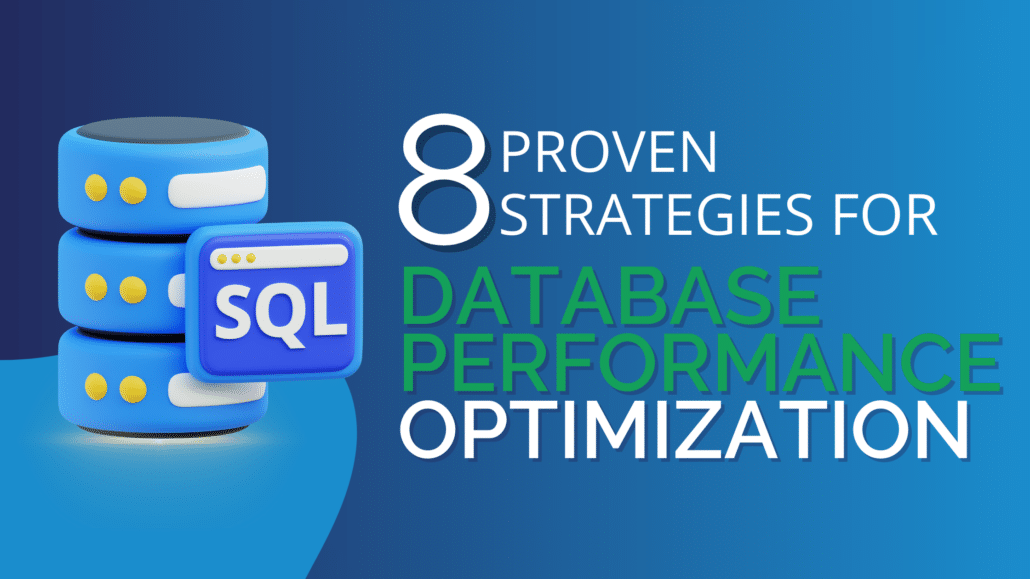8 Proven Strategies for Database Performance Optimization
It’s no secret that the efficiency of your database can significantly impact your organization’s overall performance and productivity. Whether you’re running an e-commerce platform, managing a customer relationship management (CRM) system, or overseeing complex data analytics, optimizing your database is crucial for ensuring fast, reliable, and scalable operations. Knowing and fully understanding essential proven strategies for database performance optimization will not only help you to enhance query speed, reduce latency, and maximize resource utilization, but it will help you to create a strong foundation for overall business growth.

Database Performance Optimization: 8 Effective Strategies
From indexing to query optimization, and from hardware enhancements to fine-tuning configuration settings, there are numerous techniques and best practices that can make a substantial difference in your database’s performance. By implementing these strategies, you can not only improve the responsiveness and efficiency of your database but also extend its lifespan and reduce operational costs. Join us as we delve into the essential methods and practical tips for achieving peak database performance, ensuring your system is well-equipped to handle today’s demanding workloads.
Strategy 1: Effective Database Design
Effective database design revolves around creating a well-structured schema that minimizes redundancy and maximizes data integrity. A properly designed database schema facilitates efficient data storage, retrieval, and handling, ensuring consistency and reliability in data operations.
Employ normalization techniques such as 1st, 2nd, or 3rd Normal Form (NF) to organize data into logical structures. Use primary keys and foreign keys to establish relationships between tables, thereby reducing redundancy and maintaining data integrity. Consider denormalization for performance optimization in read-heavy applications where data redundancy can improve query performance. Design databases to support future growth by expecting growth patterns and business needs.
Strategy 2: Query Optimization
Query optimization involves refining SQL queries to enhance execution speed and minimize resource consumption. Well-optimized queries speed up data retrieval and lighten server loads, improving overall database performance.
Use indexing to speed up data retrieval operations, ensuring you design and maintain indexes properly. Avoid using SELECT * and instead specify only the columns needed to reduce overhead. Improve JOIN operations by selecting the right join types (like INNER JOIN, LEFT JOIN) based on data connections and query needs.
Analyze query execution plans using tools provided by database management systems (DBMS) to identify and eliminate inefficiencies. Implement query caching mechanisms to store frequently accessed data results, reducing database load and improving response times.
Strategy 3: Data Modeling
Data modeling involves designing data structures that align with application requirements and business objectives. A well-designed data model optimizes storage efficiency, improves data availability, and ensures data integrity.
Use entity-relationship modeling techniques to define relationships between entities clearly. Choose appropriate data types and sizes to minimize storage overhead and ensure optimal performance. Think about how different data modeling approaches, like star schema or snowflake schema in data warehousing applications, affect performance. This helps in efficiently aggregating and reporting data.
Implement partitioning strategies to manage large volumes of data effectively and improve query performance. Regularly review and update data models to reflect evolving business needs and optimize database performance.
Strategy 4: Hardware and Infrastructure Optimization
Hardware and infrastructure optimization ensures that the underlying resources support the database workload effectively. Properly configured hardware prevents performance bottlenecks and ensures optimal database operation.
Allocate sufficient RAM to handle database caching and query processing effectively. Optimize CPU configurations to manage concurrent database requests efficiently. Implement storage optimizations, such as RAID configurations or solid-state drives (SSDs), to enhance data reliability and performance. Utilize database-specific hardware enhancements, such as in-memory processing capabilities, to accelerate data access and query execution.
Monitor hardware performance metrics regularly to identify and address potential bottlenecks, ensuring growth and responsiveness as the database workload grows. Implement disaster recovery and business resilience plans to mitigate risks and ensure data availability during hardware failures or system outages.
Strategy 5: Regular Monitoring and Tuning
Regular monitoring and tuning involve continuous assessment of database performance metrics and making adjustments to maintain optimal performance. Proactive monitoring helps identify performance degradation or potential issues before they impact users or operations.
Use database monitoring tools to track important performance metrics like CPU usage, memory usage, query speeds, and disk performance. Set up alerts to notify administrators of threshold breaches or anomalies in performance metrics. Establish baseline performance metrics to compare against current performance trends and identify deviations that may indicate underlying issues.
Based on monitored data, optimize indexes, queries, and database settings to enhance performance and scale effectively with varying workloads. Implement automated monitoring and tuning processes to streamline maintenance tasks and ensure continuous optimization of database performance.
Strategy 6: Scaling and High Availability
Scaling and high availability strategies ensure that databases can handle increasing data volumes and maintain uptime. growth and high availability are critical for meeting growing user demands and ensuring continuous access to critical data.
Implement horizontal scaling by distributing the database load across multiple servers using techniques like database sharding or partitioning. Vertical scaling involves upgrading hardware resources such as increasing CPU or RAM capacity to accommodate increased workload demands. Set up database clustering or replication for high availability and fault tolerance, ensuring data remains reliable and accessible despite hardware failures or network issues.
Implement load balancing mechanisms to evenly distribute incoming database requests across multiple servers, preventing overload and optimizing response times. Utilize cloud-based database solutions to leverage growth potential and flexibility, enabling rapid deployment and dynamic resource allocation based on fluctuating workload demands.
Strategy 7: Security Considerations
Security considerations involve implementing measures to protect database resources and sensitive data from unauthorized access and malicious attacks. Data breaches can have severe consequences, including financial loss, legal consequences, and damage to a company’s reputation.
Limit database access based on user roles and responsibilities by using strong verification methods like RBAC. y implementing RBAC, you can restrict access to sensitive information to only those who need it. This improves security and reduces the risk of unauthorized access. Encrypt sensitive data both at rest and in transit using strong encryption algorithms and secure communication protocols.
Implement database auditing and logging mechanisms to monitor access and changes to sensitive data, ensuring accountability and compliance with regulatory requirements. Conduct regular security assessments and vulnerability scans to identify and mitigate potential security risks. Establish incident response procedures and contingency plans to respond quickly to security incidents and minimize the impact on data integrity and availability.
Strategy 8: Optimizing Application Code
Optimizing application code focuses on writing efficient code that interacts with the database to minimize unnecessary queries and improve performance. Inefficient application code can degrade database performance, increase resource consumption, and impact overall application responsiveness.
Utilize Object-Relational Mapping (ORM) frameworks to abstract database interactions and streamline data access and handling operations. Use batch processing techniques to minimize database round-trips and enhance performance when handling large-scale data operations. Optimize transaction management to minimize locking and improve concurrency, ensuring efficient data integrity and consistency.
Regularly review and refactor application code to eliminate redundant queries, improve query efficiency, and leverage database-specific features or optimizations provided by the DBMS. Implement caching mechanisms to store frequently accessed data in memory, reducing the need for repeated database access and improving application responsiveness.
Importance of Database Optimization
Improving database performance requires a comprehensive strategy including design, monitoring, scaling, security, and efficient coding. By applying these strategies, organizations can boost database efficiency, growth, and reliability. This enhances user satisfaction, fuels business growth, and achieves operational excellence in today’s competitive landscape.
In summary, optimizing database performance enhances application reliability and efficiency, while also increasing an company’s ability to innovate and adapt to business changes. By using these strategies, businesses can maximize their data, promote growth, and stay competitive in the digital market. These strategies help manage databases effectively, leading to improved performance and efficiency. Businesses can utilize these strategies to make informed decisions and stay ahead of the competition.
Regularly update strategies to maintain high database performance is crucial. This will help achieve long-term success in a fast-paced and competitive environment.
Ready to take your database performance to the next level? Partner with Fortified Data, your trusted expert in database performance tuning and consulting services. Our team of seasoned professionals brings years of experience and cutting-edge techniques to ensure your database operates at peak efficiency. Whether you’re facing slow queries, high latency, or resource bottlenecks, we have the solutions to optimize your system and boost productivity. Don’t let database issues hinder your business growth—schedule a free consultation with Fortified Data today and discover how our tailored strategies can transform your database performance and drive success. Reach out to us now for a consultation and start your journey towards a faster, more reliable, and scalable database environment.



Leave a Reply
Want to join the discussion?Feel free to contribute!